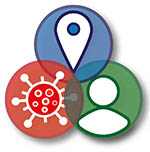
Making PROTECT count for our stakeholders
Professor Andrew Curran, Chief Scientific Adviser at the Health and Safety Executive and PROTECT study lead, reflects on the progress of the programme to date and looks forward to a critical year for securing its legacy.
2022 has started with a mixture of uncertainty and cautious optimism, as COVID-19 case rates, driven by the Omicron variant, rose, peaked, and fell, followed by the relaxation of government restrictions in the UK. There is still plenty of uncertainty, but what we do know is that, pandemic or endemic, there remains a continuing need to improve understanding of how the COVID-19 virus transmits, and how to control it.
It is therefore welcome and important news that our new year has begun with confirmation of extended funding to continue the PROTECT COVID-19 National Core Study on transmission and environment until March 2023. This milestone presents an opportunity for us to reflect on what we have achieved over the past 15 months, and the contributions we have made to the evidence base.
Back in October 2020, we had virtually no information about how the COVID-19 virus is transmitted, and so we rapidly pulled together a world-class multi-disciplinary team to understand how environmental factors, human behaviour, and the characteristics of the virus itself combine for transmission to occur.
With such a large portfolio of PROTECT projects across 20 organisations and some 200 researchers, it can sometimes be difficult to see how all the individual findings combine to deliver impact. However, it is now very clear that we have managed to unpick some of the complex factors which come together to create opportunities for transmission.
Our early observation that ‘transmission is a continuous risk’ enabled us to move away from a purely location-based model to one which considered how variable risk factors combine at any particular place and time. Meanwhile, the detailed outbreak investigations we have conducted, collecting ‘real world’ data from workplaces and workers, have shown that specific work activities aren’t the most critical risk factor, as workplaces doing the same kind of work don’t all report the same outbreak scale and impact.
Our ability to detect the virus in these workplaces, coupled with lab-based experimental work, has shown that close contact and airborne transmission are the most likely routes of transmission, with transmission via surfaces a possibility in some specific circumstances.
These observations have been supplemented by detailed ‘deep dives’ into particular employment sectors (such as transport), as well as geographical areas of the UK where COVID-19 prevalence has remained high throughout the pandemic.
All this knowledge is now being fed into models which can be used to predict the likelihood of virus transmission and the impact of control measures in a range of different situations. So, in summary, we have had a hugely productive 15 months!
The next stage of our work is to ensure we understand the critical remaining knowledge gaps identified by our stakeholders, so that we can translate our findings into suitable tools and resources to help them make evidence-based decisions.
In our final year, we will be completing ongoing experimental work, filling the gaps highlighted by our engagement work, translating our knowledge into useful and accessible formats, and ensuring that we leave a suitable legacy that helps to deal with any future pandemics.
We recognise that the funding we have received hasn’t allowed us to establish a long-term capability through PhD studentships, or make longer-term investments in addressing some of the complex scientific challenges of virus transmission. As part of our legacy work, we will therefore seek to work with others to make the case for a sustainable national capability that will deliver the critical knowledge to underpin our understanding of transmission of all current, and future, airborne biological hazards.
PROTECT is conducting a stakeholder survey to identify knowledge gaps and help inform resource allocation for the 2022-23 financial year. Take part by 7 February






0 Comments